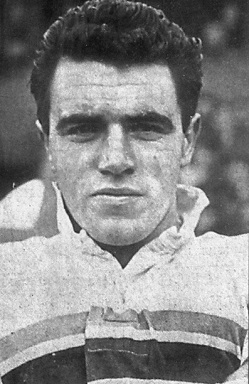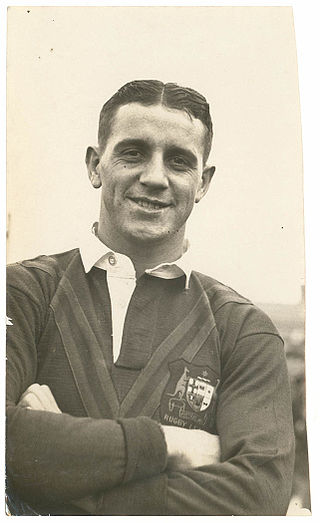Related Research Articles
Thomas Kelvin Coslett is a Welsh former dual-code international rugby union and professional rugby league footballer who played in the 1960s and 1970s, and coached rugby league in the 1970s and 1980s. He played representative level rugby union (RU) for Wales, and at club level for Aberavon RFC and Llanelli RFC, as a goal-kicking full-back, and representative level rugby league (RL) for Wales and Other Nationalities, and at club level for St. Helens (captain), and Rochdale Hornets, as a toe-end kicking style goal-kicking fullback, prop, second-row, or loose forward, and coached at club level for Rochdale Hornets, Wigan and St. Helens.
Henderson Gill is an English former professional rugby league footballer. He played for Bradford Northern, Wigan and Rochdale Hornets in the Championship and South Sydney Rabbitohs in the NSWRL competition. Gill primarily played on the wing during his career. He was capped 15 times for Great Britain between 1981 and 1988.
John Mantle was a Welsh dual-code international rugby player. He was capped for Wales at rugby union, and Great Britain and Wales in rugby league.
Colin J. Dixon was a Welsh rugby league footballer who played in the 1960s, 1970s and 1980s, and coached in the 1970s. He played club level rugby union (RU) for Cardiff International Athletic Club, and representative level rugby league (RL) for Great Britain and Wales, and at club level for Halifax (captain), Salford and Hull Kingston Rovers. He played as a centre, second-row or loose forward, and coached club level rugby league (RL) for Salford, and is a Halifax Hall of Fame Inductee.
William Hudson is an English former professional rugby league footballer who played in the 1940s and 1950s, and coached in the 1950s. He played at representative level for Great Britain, England and Yorkshire, and at club level for Batley, Wigan and Wakefield Trinity (captain), as a prop, second-row, or loose forward, i.e. number 8 or 10, 11 or 12, or 13, during the era of contested scrums, and coached at club level for Featherstone Rovers.
William Newman Ramsey was an English professional rugby league footballer who played as a prop, second-row or loose forward in the 1960s and 1970s, and coached in the 1970s. He played at representative level for Great Britain, Yorkshire, and Commonwealth XIII, and at club level for Hunslet, Leeds, Bradford Northern, Hull FC and Widnes during the era of contested scrums, and coached at club level for Hunslet. During his Leeds career Ramsey appeared in 17 major Finals, including five at Wembley Stadium, London, scored a rare drop goal in the 1969 Championship Final, toured twice in 1966 and 1974, and won seven winners medals with Leeds.

Emlyn Jenkins was a Welsh cinema manager, trainee teacher, landlord of a public house, rugby union, and professional rugby league footballer who played in the 1930s and 1940s, and coached rugby league in the 1950s. He played club level rugby union (RU) for Treorchy RFC, and Cardiff RFC, and representative level rugby league (RL) for Great Britain, Wales and England, and at club level for Salford, Wigan and St. Helens, Leigh, as a fullback, wing, centre, stand-off, or scrum-half, i.e. number 1, 2 or 5, 3 or 4, 6, or 7, and coached club level rugby league (RL) for Leigh and St. Helens.
William Blan was an English professional rugby league footballer who played in the 1940s and 1950s. He played at representative level for Great Britain, England and Lancashire, and at club level for Wigan, Leeds, St. Helens and Rochdale Hornets, as a second-row or loose forward.
Alan Spencer Edwards was a Welsh rugby union, and professional rugby league footballer who played in the 1930s and 1940s. He played club level rugby union (RU) for Aberavon RFC, the Royal Air Force, and representative level rugby league (RL) for Great Britain and Wales, and at club level for Salford, Leeds, Dewsbury, and Bradford Northern, as a wing.

Lawrence "Laurie"/"Gilly" M. Gilfedder was an English rugby union and professional rugby league footballer who played in the 1950s and 1960s. He played club level rugby union (RU) for Warrington RUFC, and representative level rugby league (RL) for Great Britain and Lancashire, and at club level for Warrington, Wigan, and Leigh, as a goal-kicking centre, second-row, or loose forward.

Shaun David Wane is an English professional rugby league coach and former professional rugby league footballer, who is currently the head coach of the England national rugby league team. He is also Leadership and Management Director of Wigan Warriors, for whom he served as head coach from 2011 to 2018 winning three Super League Grand Finals and one Challenge Cup.
Glyndwr Shaw was a Welsh dual-code international rugby union, and rugby league footballer who played in the 1970s and 1980s. He played representative level rugby union (RU) for Wales, and at club level for Neath RFC, as a prop and representative level rugby league (RL) for Great Britain and Wales, and at club level for Widnes, Wigan, Warrington and Rochdale Hornets, as a prop, or second-row.

Edward "Ted" Slevin was an English professional rugby league footballer who played in the 1940s, 1950s and 1960s. He played at representative level for Great Britain, England and Lancashire, and at club level for Wigan, Huddersfield and Rochdale Hornets, as a prop, or second-row, i.e. number 8 or 10, or, 11 or 12, during the era of contested scrums.

John Aubrey Casewell was a Welsh professional rugby league footballer who played in the 1920s and 1930s, and coached in the 1940s. He played at representative level for Wales, and at club level for Salford, Leeds, Halifax and Keighley, as a second-row, coached at club level for Featherstone Rovers and Hunslet Engine Company ARLFC, and he was the Secretary of the Leeds and District Rugby League.
Colin Whitfield is an English former professional rugby league footballer who played in the 1980s and 1990s, and coached in the 1990s. He played at club level for Salford, Wigan, Halifax, Canterbury-Bankstown and the Rochdale Hornets, as a fullback, wing, or centre, and coached at club level for Widnes.
Harold "Hal" James Jones was a Welsh rugby union, and professional rugby league footballer who played in the 1920s and 1930s. He played representative level rugby union (RU) for Wales, and at club level for Neath RFC, Maesteg RFC, Cardiff RFC, Glamorgan Police RFC and Glamorgan County RFC, as a lock, i.e. number 4 or 5, and representative level rugby league (RL) for Wales, and at club level for Wigan and Keighley as a prop, or second-row, i.e. number 8 or 10, or, 11 or 12, during the era of contested scrums.
Leonard Tasman Mason was a New Zealand professional rugby league footballer who played in the 1920s and 1930s. He played at representative level for New Zealand, Other Nationalities, Dominion XIII, the South Island, South Auckland and Canterbury, and at club level for Wigan, Keighley and Bramley, as a centre, prop, hooker, or second-row.
Nathan Silcock was an English professional rugby league footballer who played in the 1920s and 1930s. He played at representative level for Great Britain, England, Rugby League XIII and Lancashire, and at club level for Widnes (captain), as a prop, or second-row, i.e. number 8 or 10, or, 11 or 12, during the era of contested scrums.

Hector Arthur Gee was an Australian professional rugby league footballer who played in the 1930s and 1940s. He played at representative level for Australia, Queensland, British Empire XIII and Dominion XIII, and at club level in Australia for Tivoli, and in England for Wigan, Leeds, and Batley, as a stand-off, or scrum-half, i.e. number 6, or 7.

William John Holding was an English professional rugby league footballer who played in the 1920s, 1930s and 1940s. He played at representative level for Cumberland, and at club level for Warrington, and Rochdale Hornets as a goal-kicking fullback, i.e. number 1.
References
- ↑ "The Leeds Loiner - Challenge Cup semi-final - Keighley v. Wakefield Trinity, Saturday 3 April 1937". footballzone.co.uk. 31 December 2016. Archived from the original on 28 March 2017. Retrieved 1 January 2017.
- ↑ "Statistics at wigan.rlfans.com". wigan.rlfans.com. 31 December 2016. Retrieved 1 January 2017.